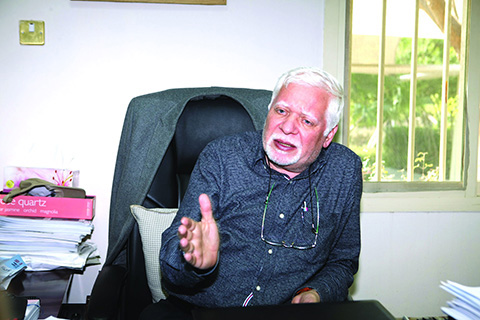 KUWAIT: Dr Mostafa A Mahmoud, Wildlife and Zoo Management Specialist, speaks to Kuwait Times. — Photos by Joseph Shagra
KUWAIT: Dr Mostafa A Mahmoud, Wildlife and Zoo Management Specialist, speaks to Kuwait Times. — Photos by Joseph ShagraAlthough it is a hot desert country, Kuwait has many native animals and birds. Unfortunately, most of them have disappeared, while others are endangered and may become extinct soon. "The last inventory of wild animal species in Kuwait proved the presence of more than 300 birds, 20 mammals and 40 reptiles. The majority of large mammals that were native to Kuwait were wiped out or have disappeared. This is a result of ecological and man-made factors," Dr Mostafa A Mahmoud, Wildlife and Zoo Management Specialist, told Kuwait Times.
According to him, the ecological factors are represented by desertification, while human related activities include habitat destruction, overgrazing, pollution and illegal hunting. All these factors led to a decrease in the number of many native animals or their extinction. "The large mammals that disappeared from our environment include two species of gazelle - dorcas gazelle and the sand gazelle - and the Arabian oryx. These have disappeared completely.
The carnivores that disappeared include the caracal, cheetah, fennec fox and the Arabian wolf. Most of these were native to the Arabian peninsula. Only a small number of Arabian wolfs exist, and they live near the Kuwaiti-Iraqi border and the Kuwaiti-Saudi border," said Mahmoud.
Birds
The native birds that became extinct from the local environment include the houbara bustard and the lanner falcon. "Both these birds were reproducing in Kuwait, but disappeared due to the above-mentioned factors," he stressed. Most pigeons in Kuwait are not wild, so people breed them and they represent a great part of the Kuwaiti fauna. "The typical kinds in Kuwait are the palm dove and turtle dove, while the only wild pigeon is the rock pigeon. Then there are some kinds that entered the Kuwaiti environment, such as the Namaqua dove, which breeders reproduced and it became a local pigeon," he said.
Other species of birds also became popular locally, although they are not native to Kuwait, such as rose-ringed parakeets, which have become very popular birds in Kuwait. "Some people brought these birds and released them in the wild accidently or intentionally. There are no deep studies on all introduced species in Kuwait," Mahmoud added.
The exact years when native animals and birds became extinct are unknown. "The last Arabian oryx recorded in the Arabian Peninsula was in 1960. The case is similar for other large mammals such as the deer and others, which started to become extinct in the beginning of the 1960s as a result of the above-mentioned factors," he pointed out.
It is a chain reaction affecting all creatures as they depend on each other. "The vegetation cover decreased due to many factors including damage to the environment, increasing temperatures and grazing by herbivores. Then the herbivores started to disappear, who were prey for carnivores such as the cheetah and caracal. As a result, the carnivores did not find nutrition and started to disappear too," Mahmoud told Kuwait Times.
The reptiles did not face the danger of extinction in the same way as the mammals and birds. "But if the factors of environmental deterioration and man-made damaging activities continue in this way, many reptiles may also disappear. One of the reptile species that is subjected to man-made extermination is the spiny-tailed lizard. This lizard is frequently hunted as people in this region eat it. And if this behavior continues, this lizard will disappear soon, as it's already listed on the IUCN red list as an endangered species," he noted.
This list includes all the animals in the world, that are then placed in categories - critically endangered, endangered, vulnerable, threatened and common list concern. "They divide the animals according to the population size in the areas where these animals exist, and the degree of the danger of extinction. Most native animals of Kuwait are in the first category - critically endangered - like the cheetah, which is in this category worldwide. The number of cheetahs has now reached around 1,000-1,500 in the areas where they live," said Mahmoud.
Hunting ban
Article 100 of Kuwait's environmental law number 42/2014 bans hunting, collecting or destruction of nests in the areas where these wild species live in Kuwait. "This law started to be implemented in 2014. This article mentions that these native creatures, including all mammals, birds and reptiles, cannot be killed, collected, hunted, have their nests destroyed, or be harmed by any activity.
The penalties can reach up to three years of imprisonment. This is one of the positive steps taken by the government to protect the animals. The environmental police is enforcing this law. They have in fact arrested many violators hunting or polluting the environment, and there is a specialized department for these violations," he explained.
Kuwait Zoo is home to some of the native animals. "There are two kinds of native herbivores in the zoo - the Arabian oryx and the dorcas gazelle. Both species are bred at the zoo, but there is no complete program for the reproduction of these animals and releasing them in the wild, which plays a great role in protecting native life. Many international zoos have reproduction programs for endangered animals in order to resettle them in the natural environment.
If there was similar program, we would be able to reproduce the deer and release it in natural reserves to protect them and preserve their existence," Mahmoud said. "The zoo has a surplus of many animals, especially the deer. We provided some of these deer to the Sheikh Sabah Natural Reserve. We welcome any cooperation for exchanging animals, but this should be done correctly in order to make similar programs successful," concluded Mahmoud.
By Nawara Fattahova, Staff Writer










